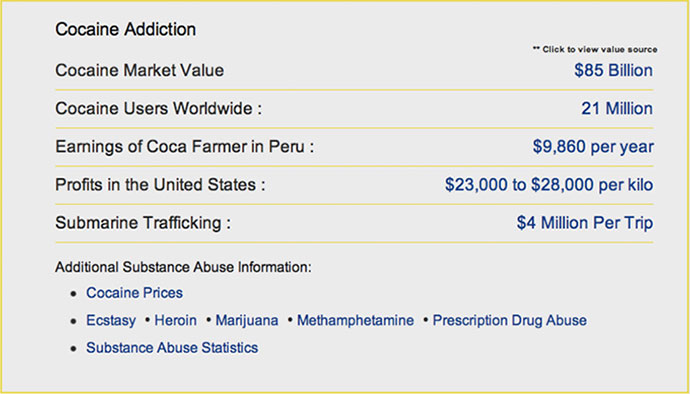
Key Concepts
Question of the Day
Why is it that mankind assigns such great value to a natural product such as cocaine which causes so much misery and dysfunction?
Lesson of the Day
There are four categories of ecosystem services.
Provisioning services, like food products, energy or medicines have assigned monetary values. However most ecosystem services have no assigned value. What is the value of the wetland that purifies water? Evidently wetlands have had little value to humanity as a significant percentage have been destroyed to make way for development.
The Coca Tree is an interesting environmental element to consider. As a plant it provides regulating services as a sink for carbon. The coca leaf also plays an important cultural role in Peruvian society, playing a vital role in the religious cosmology of the Andean people. It also has pragmatic use as a medicinal plant. However the Coca leaf is now in huge demand globally because of a world-wide cocaine market valued at 85 billion dollars. Peru is the largest producer of cocaine in the world, the United States the largest consumer.

What is the true value of the ecosystem service that the coca leaf provides? Can one separate traditional uses from the world-wide drug trade? How can we reconcile the great monetary value assigned to coca leaves when they result in significant misery around the world?
Would the world be a better place without the coca leaf, or is the problem not the leaf but mans tendency to abuse?
Words to Run By
Daily Dispatch
The first few nights of Expedition Peru, team members snuggled deep in sleeping bags to ward off the cold, damp Andean night. Two short days later - and 10,000 feet lower - the excessive heat is the concern; today the temperature reached thirty-eight degrees as the Youth Ambassadors wound down jungle roads and through pineapple, banana, and coca plantations. The coca plant has deep cultural roots in Peru that belie its reputation as the source of a world-wide recreational drug epidemic. In Peru coca plants grow best at about 1000 meters elevation, and plantations were scattered along the route as the team descended into the Amazon basin. The use of coca for medicinal and ceremonial purposes dates back to the time of the Incan Empire. A German chemist first isolated cocaine from coca leaves in 1859; today the global cocaine industry is valued at 85 billion dollars. Local people reassured the i2P team that cocaine abuse is virtually unknown in the communities where coca is grown and harvested. Rather the plant maintains a deep cultural resonance, as the Youth Ambassadors learned from one of our guides on a tepid jungle evening when he gave three coca leaves to each as a sign of respect.
Video of the Day
Photo of the Day
Coming soon.
Expert Video
Coming soon.
School Activities
Coming soon.
Youth Ambassador Activity
Locate a Coca Tree and harvest a few leaves. Establish what ecosystem services these leaves provide in the domains of:
Consider the monetary value of these leaves. Does this value reflect the value of the ecosystem services they provide? Consider impact of this very valuable commodity on human health & wellbeing
Note: the United State spends $40 billion annually on drug control. Factor in the health and other social costs and cocaine is an expensive habit.
Links